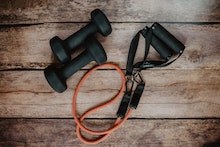Header Photo by Kelly Sikkema on Unsplash
Panting, I reached the tenth rep out of twelve in my conventional deadlift. I’d gone about ten pounds lighter than the previous time I’d done this exercise (to account for a few extra reps each set), so I wasn’t sure why I was struggling so much.
The truth is, there are a great deal of factors that can influence your workout. Obviously your diet and recovery (hello, proper sleep habits) play vital roles, but there are plenty of outside influences to be aware of as well. Here are 3 external factors that affect your workout.
Temperature
For me, my struggles came from the temperature of my house. We don’t have air conditioning, and California was (is, as of this writing) currently in the middle of an unprecedented heat wave.

Now, I’d taken precautions to exercise safely in the heat. It was before 11am, so it was a cooler part of the day. I had chilled water beside me and a fan pointed at me. So why were the deadlifts I’d previously crushed now so difficult?
Heat affects us in more ways than we know. As your body temperature increases, your circulatory system and central nervous system are impacted. So the way your blood moves through your body and your brain’s connection to your movements are affected.
Sounds like two body systems essential for exercise, no?
It gets worse when the temperatures don’t drop low enough at night. Our bodies thermoregulate, naturally dropping in temperature as we get closer to night time in preparation for sleep. When they can’t drop low enough, our sleep quality declines. This means we don’t get the rest and recovery we need to complete a workout the next day.
Tips to Help
Honestly, the best way to get through a heat wave when you don’t have air conditioning is probably not to exercise.
If that’s intolerable to you, however, try these tips:
- Only exercise in the morning or evening, when the temperatures are lower.
- Wear loose, flowing clothing.
- Keep chilled water close by and sip from it frequently.
- Stick to gentler exercises, like yoga flows or walking on a treadmill, rather than intense lifts or runs.
- If you notice any abnormality in your body (fatigue, ceasing to sweat, faintness, dizziness, etc.) cease exercising immediately. Find a cool area to rest and drink fluids with electrolytes.
Air Quality

When you exercise, your breathing usually elevates as your blood demands more oxygen to handle the stress of the workout.
So what happens if the air quality is poor, or even terrible?
Right now, as fires rage across California thanks to a random lightning storm (storm was cool, resulting fires not so much) the air quality where I live is bad. Like, I woke up this morning and it looked like someone had placed a yellow, post-apocalyptic filter over the entire city levels of bad.
Fortunately, it’s a rest day for me. Even sitting in a room without an air filter caused me to feel fuzzy headed with a tickle in my throat.
Pollution, smog, or other particulate matter can also affect the air quality in your space. When the air quality is bad, your body doesn’t get the oxygen it needs to power your workout.
Tips to Help
I hate to break it to you, but there really isn’t a good fix for bad air. I strongly recommend not doing a workout when the air quality is poor. Your lungs are bringing that air into your body and your heart pumps that air to the muscles doing the exercise.

You wouldn’t put dirty fuel in your car or a moldy filter in your water bottle, would you? The same principle applies here.
If you have a closed room and a very powerful air filter or filtration system, you might be able to get away with mild exercise. But your best bet is just to wait for the air to clear.
Your Environment
The previous two external factors are usually completely out of your control. Where you live is a bit more within your ability to influence; however, there are still instances in which people’s environments outside their homes act as a barrier to exercise.
Of course, there are endless racial, socioeconomic, and cultural factors that affect where someone lives, and it’s vital to address these. That topic is too large for this post (maybe I’ll tackle it in the future) but for the purposes of this section, let’s assume someone’s location is somewhat outside of their control (they can’t afford rent elsewhere, their family is nearby, etc.)

The environment outside your home can absolutely affect your workout. For example, if you’re a runner who can’t afford a treadmill and depends on exercising outside, but your neighborhood is unsafe or there aren’t trails near you, this presents a problem.
Lack of access to recreational facilities like gyms or community centers is also an issue (though less so now that they’re all closed thanks to COVID). When gyms are open, traffic or lack of public transportation can inhibit folks from getting to their exercise building of choice.
Tips to Change
Unfortunately this is another tough one to change. As I mentioned, sometimes your living situation is what it is and you can’t just pick up and move to a more desirable location.
However, there are a few ways to potentially make working out outside work for you:
- If your neighborhood isn’t safe and you have transportation, try driving to an outdoor track, field, park, or nearby hiking trail to complete your workout.
- If you lack transportation and need away from your area (once the virus calms), see if you can set up a ride share to a more desirable workout location.
- Stay inside. Use the power of the internet to find a comparable workout you can do from the safety and comfort of your home.
What Have You Noticed Affecting Your Workouts?
Especially in the insane year that is 2020, there must be other factors I’ve missed that you’ve encountered. What have you noticed? How did you work around them? Let me know!
And, as always, if you like what I write, let’s get in touch. I’m constantly open to new writing and networking opportunities!
